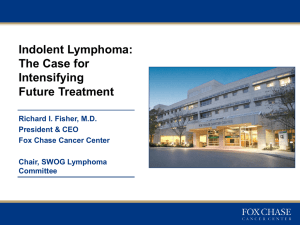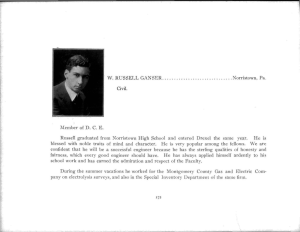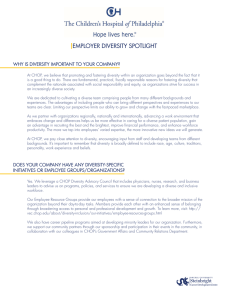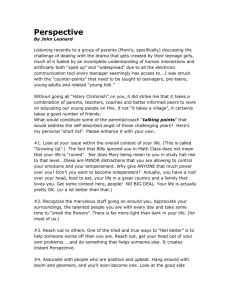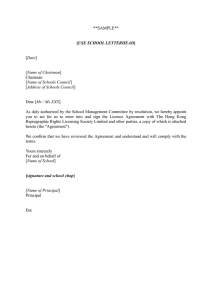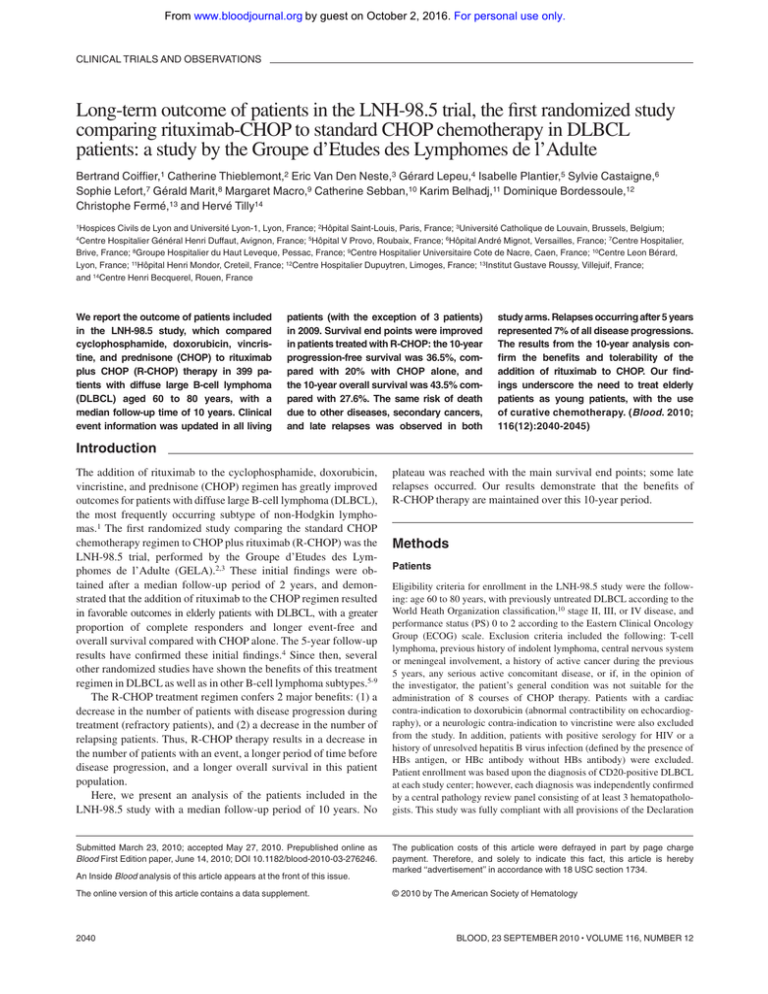
From www.bloodjournal.org by guest on October 2, 2016. For personal use only.
CLINICAL TRIALS AND OBSERVATIONS
Long-term outcome of patients in the LNH-98.5 trial, the first randomized study
comparing rituximab-CHOP to standard CHOP chemotherapy in DLBCL
patients: a study by the Groupe d’Etudes des Lymphomes de l’Adulte
Bertrand Coiffier,1 Catherine Thieblemont,2 Eric Van Den Neste,3 Gérard Lepeu,4 Isabelle Plantier,5 Sylvie Castaigne,6
Sophie Lefort,7 Gérald Marit,8 Margaret Macro,9 Catherine Sebban,10 Karim Belhadj,11 Dominique Bordessoule,12
Christophe Fermé,13 and Hervé Tilly14
1Hospices
Civils de Lyon and Université Lyon-1, Lyon, France; 2Hôpital Saint-Louis, Paris, France; 3Université Catholique de Louvain, Brussels, Belgium;
Hospitalier Général Henri Duffaut, Avignon, France; 5Hôpital V Provo, Roubaix, France; 6Hôpital André Mignot, Versailles, France; 7Centre Hospitalier,
Brive, France; 8Groupe Hospitalier du Haut Leveque, Pessac, France; 9Centre Hospitalier Universitaire Cote de Nacre, Caen, France; 10Centre Leon Bérard,
Lyon, France; 11Hôpital Henri Mondor, Creteil, France; 12Centre Hospitalier Dupuytren, Limoges, France; 13Institut Gustave Roussy, Villejuif, France;
and 14Centre Henri Becquerel, Rouen, France
4Centre
We report the outcome of patients included
in the LNH-98.5 study, which compared
cyclophosphamide, doxorubicin, vincristine, and prednisone (CHOP) to rituximab
plus CHOP (R-CHOP) therapy in 399 patients with diffuse large B-cell lymphoma
(DLBCL) aged 60 to 80 years, with a
median follow-up time of 10 years. Clinical
event information was updated in all living
patients (with the exception of 3 patients)
in 2009. Survival end points were improved
in patients treated with R-CHOP: the 10-year
progression-free survival was 36.5%, compared with 20% with CHOP alone, and
the 10-year overall survival was 43.5% compared with 27.6%. The same risk of death
due to other diseases, secondary cancers,
and late relapses was observed in both
study arms. Relapses occurring after 5 years
represented 7% of all disease progressions.
The results from the 10-year analysis confirm the benefits and tolerability of the
addition of rituximab to CHOP. Our findings underscore the need to treat elderly
patients as young patients, with the use
of curative chemotherapy. (Blood. 2010;
116(12):2040-2045)
Introduction
The addition of rituximab to the cyclophosphamide, doxorubicin,
vincristine, and prednisone (CHOP) regimen has greatly improved
outcomes for patients with diffuse large B-cell lymphoma (DLBCL),
the most frequently occurring subtype of non-Hodgkin lymphomas.1 The first randomized study comparing the standard CHOP
chemotherapy regimen to CHOP plus rituximab (R-CHOP) was the
LNH-98.5 trial, performed by the Groupe d’Etudes des Lymphomes de l’Adulte (GELA).2,3 These initial findings were obtained after a median follow-up period of 2 years, and demonstrated that the addition of rituximab to the CHOP regimen resulted
in favorable outcomes in elderly patients with DLBCL, with a greater
proportion of complete responders and longer event-free and
overall survival compared with CHOP alone. The 5-year follow-up
results have confirmed these initial findings.4 Since then, several
other randomized studies have shown the benefits of this treatment
regimen in DLBCL as well as in other B-cell lymphoma subtypes.5-9
The R-CHOP treatment regimen confers 2 major benefits: (1) a
decrease in the number of patients with disease progression during
treatment (refractory patients), and (2) a decrease in the number of
relapsing patients. Thus, R-CHOP therapy results in a decrease in
the number of patients with an event, a longer period of time before
disease progression, and a longer overall survival in this patient
population.
Here, we present an analysis of the patients included in the
LNH-98.5 study with a median follow-up period of 10 years. No
Submitted March 23, 2010; accepted May 27, 2010. Prepublished online as
Blood First Edition paper, June 14, 2010; DOI 10.1182/blood-2010-03-276246.
An Inside Blood analysis of this article appears at the front of this issue.
The online version of this article contains a data supplement.
2040
plateau was reached with the main survival end points; some late
relapses occurred. Our results demonstrate that the benefits of
R-CHOP therapy are maintained over this 10-year period.
Methods
Patients
Eligibility criteria for enrollment in the LNH-98.5 study were the following: age 60 to 80 years, with previously untreated DLBCL according to the
World Heath Organization classification,10 stage II, III, or IV disease, and
performance status (PS) 0 to 2 according to the Eastern Clinical Oncology
Group (ECOG) scale. Exclusion criteria included the following: T-cell
lymphoma, previous history of indolent lymphoma, central nervous system
or meningeal involvement, a history of active cancer during the previous
5 years, any serious active concomitant disease, or if, in the opinion of
the investigator, the patient’s general condition was not suitable for the
administration of 8 courses of CHOP therapy. Patients with a cardiac
contra-indication to doxorubicin (abnormal contractibility on echocardiography), or a neurologic contra-indication to vincristine were also excluded
from the study. In addition, patients with positive serology for HIV or a
history of unresolved hepatitis B virus infection (defined by the presence of
HBs antigen, or HBc antibody without HBs antibody) were excluded.
Patient enrollment was based upon the diagnosis of CD20-positive DLBCL
at each study center; however, each diagnosis was independently confirmed
by a central pathology review panel consisting of at least 3 hematopathologists. This study was fully compliant with all provisions of the Declaration
The publication costs of this article were defrayed in part by page charge
payment. Therefore, and solely to indicate this fact, this article is hereby
marked ‘‘advertisement’’ in accordance with 18 USC section 1734.
© 2010 by The American Society of Hematology
BLOOD, 23 SEPTEMBER 2010 䡠 VOLUME 116, NUMBER 12
From www.bloodjournal.org by guest on October 2, 2016. For personal use only.
BLOOD, 23 SEPTEMBER 2010 䡠 VOLUME 116, NUMBER 12
of Helsinki and was conducted according to Good Clinical Practice
guidelines. The study protocol was approved by the institutional review
boards or ethics committees of all participating centers, and all patients
provided written informed consent prior to enrolment in the study.
The baseline characteristics of the 399 patients included in our study
population were identical across both study arms, and have been described
in previous publications.3,4 Median age was 70 years and is now 80 years,
with the oldest patient being 91 years old. Only 20% of the patients had
localized stage; 31% had a tumor larger than 10 cm; 66% had elevated
lactate dehydrogenase levels; and the age-adjusted International Prognostic
Index (aaIPI) score was 2 or 3 in 60% of the patients.
Staging consisted of clinical examination, thoracic and abdominal
computed tomography (CT) scans, blood counts, measurements of lactate
dehydrogenase and 2-microglobulin serum levels, bone marrow biopsy,
electrocardiogram, echocardiography in patients with a history of cardiac
disease or in patients older than 75 years, and cerebrospinal fluid examination
in patients with bone marrow infiltration or head and neck involvement, or if
otherwise clinically indicated.
Randomization and treatment
Patients were centrally randomized to treatment with either CHOP or
R-CHOP after stratification according to study center and aaIPI scores (0 or
1 vs 2 or 3).11 Patients treated with CHOP received 750 mg/m2 cyclophosphamide, 50 mg/m2 doxorubicin, 1.4 mg/m2 vincristine up to a maximum
dose of 2 mg on day 1, and 40 mg/m2/day prednisone on days 1 to 5,
for each treatment cycle. Patients underwent 1 cycle of treatment every
3 weeks, for a total of 8 cycles. Patients treated with R-CHOP received
rituximab at a dose of 375 mg/m2 on day 1 of each of the 8 cycles.
Rituximab infusion was interrupted in the event of fever, chills, edema,
mucosal congestion, hypotension, or any serious adverse event, and was
resumed later. No complementary radiation therapy was planned for the
treatment of bulky tumors or on persisting tumor masses at the end of
treatment.
If a patient developed grade 4 neutropenia or febrile neutropenia after a
cycle of CHOP or R-CHOP, all subsequent cycles were administered with
granulocyte colony-stimulating factor (G-CSF) supportive therapy. When
the onset of grade 4 neutropenia occurred alongside an infection despite
G-CSF support, the doses of cyclophosphamide and doxorubicin were
decreased by 50% for all the following cycles. If grade 4 neutropenia
persisted, chemotherapy was discontinued. If a patient developed grade 3 or
4 thrombocytopenia, the doses of cyclophosphamide and doxorubicin were
decreased by 50% for all the following cycles. If grade 3 or 4 thrombocytopenia persisted, chemotherapy was discontinued. If neutrophil levels were
lower than 1.5 G/L or platelet levels lower than 100 G/L before a treatment
cycle, the treatment was delayed for up to 2 weeks. If the patient’s
neutrophil and platelet counts did not rise above these levels after 2 weeks,
chemotherapy was discontinued. For patients in the R-CHOP arm, rituximab treatment was also discontinued if CHOP therapy was stopped.
Subsequent treatments for patients withdrawn from CHOP or R-CHOP
therapy were administered at the discretion of the investigator.
Follow-up
Response to treatment was evaluated after 8 treatment cycles, or after
stopping the planned treatment. Subsequently, clinical examination was
performed every 3 months for the first 2 years, then every 6 months for the
next 3 years, and thereafter at the discretion of the investigator. A thoracic
and abdominal CT scan was performed after 3 months, then every 6 months
during the first 2 years, and then annually for the following 3 years.
All the departments in which the patients were treated were contacted
for the follow-up information. When necessary, the relevant information
was obtained from the patients’ private physicians or, in some cases, the
patients or family members. All patients were updated for information on
events in 2009 (July 1, 2009, was the cut-off date for patients still alive),
with the exception of 3 cases where the last follow-up was at 14 months,
33 months, and 5 years. The median follow-up period was 10 years in both
study arms.
RITUXIMAB-CHOP TREATMENT IN ELDERLY DLBCL PATIENTS
2041
Table 1. Number of events observed in the CHOP and R-CHOP arms
after a 10-year median follow-up period
Type of event
CHOP
R-CHOP
44 (22.3%)
19 (9.4%)
New unplanned treatment
9 (4.6%)
11 (5.4%)
Progression after stable disease
1 (0.5%)
1 (0.5%)
PD after partial response
5 (2.5%)
6 (3.0%)
PD during treatment
Relapse for CR patients
71 (36.0%)
49 (24.3%)
Death without PD during
12 (6.1%)
12 (5.9%)
treatment
Death without PD after treatment
16 (8.1%)
33 (16.3%)
No event
39 (19.8%)
71 (35.1%)
CHOP indicates cyclophosphamide, doxorubicin, vincristine and prednisone;
R-CHOP, rituximab-CHOP; PD, progressive disease; and CR, complete response.
Outcome measures
The primary efficacy parameter was event-free survival (EFS). Events were
defined as the following: disease progression or relapse, initiation of a new
(unplanned) anticancer treatment (eg, radiation therapy), or death from any
cause without progression. Secondary efficacy end points included overall
survival (OS), progression-free survival (PFS), disease-free survival (DFS),
response rates, and toxicity. The definition of PFS was almost identical to
that of EFS, with the exception that late deaths not related to the underlying lymphoma or its treatment were not considered treatment failures.12
DFS only included patients who reached a complete response (CR) or
undocumented CR (CRu) at the end of the treatment. EFS, PFS, and OS
were calculated as the time from randomization to the date of the first
reported event. DFS was calculated as the time from response assessment to
the date of the first reported event. Patients with no reported event at the
time of analysis were censored at the most recent assessment date. Tumor
responses were classified as CR, CRu, partial response (PR), stable disease
(SD), or progressive disease (PD) according to the criteria proposed by the
International Workshop.12 Survival in relapsing patients was defined as
the duration from the first day of the new treatment to the time of death, or
last visit.
Statistical analysis
The sample size was calculated to detect an increase in the 3-year EFS rate
from 30% to 45%. It was estimated that 400 patients recruited over 3 years
and followed for a minimum of 1 year would be required to provide 80%
power at the overall 5% (⬀ ⫽ .05, 2-sided) significance level. One patient
was not included in the final analysis because she withdrew consent.
EFS, PFS, DFS, and OS were analyzed using the log-rank test and
expressed as Kaplan-Meier plots. Analyses of efficacy and safety followed
the intent-to-treat principle and included all 399 patients randomized
between August 1998 and March 2000. Statistical analyses were performed
using SAS Version 9.1.3 software (SAS Institute) by the GELA statistical
department. All P values given are 2-tailed.
Results
Previously published response rates for the R-CHOP and CHOP
study arms were the following: 75% and 63% for CR and CRu, 8%
and 6% for uncompleted responses (PR and SD), 9% and 22% for
PD, and 6% in both arms for death during treatment, respectively
(P ⫽ .005).3,4 Among the 197 patients treated with CHOP,
158 (80.2%) had an event, in comparison to 131 of the 202 patients
(64.9%) treated with R-CHOP (P ⬍ .0001; Table 1).
A total of 204 patients had progressive disease, 124 (62.9%) in
the CHOP arm and 80 (39.6%) in R-CHOP arm. Seventy-seven
patients died without progressive disease, 31 (15.7%) in the CHOP
arm and 46 (22.8%) in the R-CHOP arm. Among the 204 patients
with progressive disease, 178 (87%) occurred during the first
From www.bloodjournal.org by guest on October 2, 2016. For personal use only.
2042
COIFFIER et al
BLOOD, 23 SEPTEMBER 2010 䡠 VOLUME 116, NUMBER 12
Figure 1. Progression-free survival in patients treated with
CHOP and R-CHOP. Median progression-free survival (PFS) was
1.2 years (95% CI: .9-1.8) in the cyclophosphamide, doxorubicin,
vincristine, and prednisone (CHOP) arm and 4.8 years (95% CI:
2.7-7.6) in the CHOP plus rituximab (R-CHOP) arm (P ⬍ .0001).
3 years of follow-up (90% in the CHOP arm and 83% in the
R-CHOP arm), 12 (6%) during years 4 and 5 (5% in the CHOP arm
and 8% in the R-CHOP arm), and 14 (7%) after 5 years (5% in the
CHOP arm and 10% in the R-CHOP arm). Ten-year PFS was
20.1% (95% confidence interval [CI]: 14.6-26.2) in the CHOP arm
and 36.5% (95% CI: 29.7-43.3) in the R-CHOP arm. Progressionfree survival is depicted in Figure 1. PFS according to aaIPI score is
presented in supplemental Figure 1 (available on the Blood Web
site; see the Supplemental Materials link at the top of the online
article).
Two hundred fifty-two patients died, 140 (71.1%) in the CHOP
arm and 112 (55.4%) in the R-CHOP arm. Causes of death in the
CHOP and R-CHOP arms were lymphoma progression (68% and
56%, respectively), treatment toxicity (11% and 13%, respectively;
only 2% in each arm due to infection), another cancer (9% in both
arms), other diseases (11% and 21%, respectively) or unknown
causes (1 and 3 patients, respectively). More patients died from
causes unrelated to lymphoma or its treatment in the R-CHOP arm
but no pattern emerged, as most of the underlying conditions
related to the deaths were present before the diagnosis of DLBCL.
Most of the causes were cardiovascular diseases, 10 in the CHOP
arm and 16 in the R-CHOP arm. Ten-year OS was 27.6% (95% CI:
21.4-34.3) in patients treated with CHOP and 43.5% (95% CI:
36.4-5.4) in patients treated with R-CHOP. The OS is depicted in
Figure 2. OS according to aaIPI score is presented in supplemental
Figure 2.
For the assessment of disease-free survival, only patients with
CR or CRu were included in the analysis: 10-year DFS was 42.6%
(95% CI: 33.6-51.4) in the CHOP arm and 64.3% (95% CI:
55.4-71.9) in the R-CHOP arm. DFS is shown in Figure 3.
Figure 2. Overall survival in patients treated with CHOP and
R-CHOP. Median overall survival (OS) was 3.5 years (95% CI:
2.2-5.5) in the CHOP arm and 8.4 years (95% CI: 5.4-not
reached) in the R-CHOP arm (P ⬍ .0001).
The prognosis for survival after disease progression is poor for
most patients, regardless of the type of progressive disease. The
median OS after progression was 0.6 and 0.7 months for the CHOP
and R-CHOP arms, respectively. However, some patients responded well to salvage therapy and had a relatively long survival
period after progression: the 5- and 10-year survival after progression were 14.6% and 10.5% in the CHOP arm, compared with
25.0% and 8.6% in the R-CHOP arm, respectively (Figure 4).
No standard salvage therapy was recommended in the study
protocol; this was determined at the discretion of the investigator.
Rituximab-containing salvage treatment regimens were not administered for early disease progressions, as the drug was not available
in Europe outside the clinical trial setting during this time.
However, most of the late relapses (those occurring after 2002)
were treated with rituximab-containing chemotherapy. Overall, the
number of patients exhibiting late disease progression was low, but
there was a trend toward a better outcome for those patients treated
with R-CHOP compared with those treated with CHOP alone
(Table 2). The median age at time of progression was 72 years and
did not influence the response to salvage therapy. In a multivariate
analysis of parameters associated with long term survival after
progression, only low aaIPI score (0 or 1) and long duration of PFS
(longer than 1 year) were statistically found to be associated with a
longer survival after progression (P ⬍ .001 in both cases). No
difference was observed between the 2 arms (rituximab or not in
first line).
Forty-three patients (10.8%) developed another cancer after
entering the study, 22 in the CHOP arm and 21 in the R-CHOP arm.
Twenty-eight of these patients died, 16 in the CHOP arm, with
death being secondary to the second cancer in 12 patients, and 12 in
From www.bloodjournal.org by guest on October 2, 2016. For personal use only.
BLOOD, 23 SEPTEMBER 2010 䡠 VOLUME 116, NUMBER 12
RITUXIMAB-CHOP TREATMENT IN ELDERLY DLBCL PATIENTS
2043
Figure 3. Disease-free survival in patients treated with CHOP
and R-CHOP. Median disease-free survival (DFS) was 3.4 years
(95% CI: 1.6-not reached) in the CHOP arm and was not yet
reached (95% CI: not reached-not reached) in the R-CHOP arm
(P ⬍ .0001).
the R-CHOP arm, with death being secondary to the second cancer
in 10 patients. Three patients developed a third cancer, 1 in the
CHOP arm and 2 in the R-CHOP arm, so a total of 46 cancers were
observed in 43 patients after entering the study. There was no
pattern in the type of secondary cancers that occurred: myelodysplasia or acute myeloid leukemia was observed in 2 patients in each
arm. The most frequently observed solid tumors in the CHOP and
R-CHOP arms were in the lung (7 and 4, respectively), colon (3 and
4, respectively), prostate (3 and 2, respectively), breast (3 and 1,
respectively) and bladder (0 and 2, respectively). All other cancers
were present in 1 patient (kidney, melanoma, multiple myeloma,
ovary, liver, pleura, head and neck, esophagus, skin epidermoid,
and 1 of unknown origin).
Discussion
The 10-year follow-up results from the LNH-98.5 trial, the first
randomized study comparing the standard CHOP regimen to
R-CHOP, confirm the benefits of adding rituximab to CHOP for
the treatment of patients with DLBCL. The addition of rituximab
improved PFS and OS rates in this patient population, with an
overall increase of 16% versus CHOP alone. This difference was
even more pronounced in patients exhibiting CR at the end of
treatment (22%).
The patient cohort chosen for this trial was elderly DLBCL
patients (60-80 years of age), a particularly challenging group to
manage and treat. With the improvements in PFS and OS rates from
the addition of rituximab to standard treatment regimens, a
significant proportion of elderly patients experience long-term
survival. At 10 years, more than 40% of the patients in our study
were alive and in first CR. This emphasizes that the goal of
treatment in elderly patients, as in younger patients, should be the
cure of the lymphoma.
No plateau was reached for any of the survival end points as
shown in Figures 1 and 2. This is explained by the late relapses and
death from other causes (either related or unrelated to the lymphoma or its treatment) in this relatively elderly group of patients.
The higher mortality rate found in our study is likely due to the
advanced age of the patient population. Currently, the median age
of our patient cohort is 80 years. This is an old group of patients in
which other diseases have been observed (often related to the cause
of death), even taking into account the increasing median age of the
standard population over the past 50 years. We observed a high risk
of death due to cardiovascular diseases or secondary cancers; in
general, these are the most frequent causes of death in this age
group. We did not observe a higher occurrence of any cause of
death or development of secondary cancer in the R-CHOP arm
compared with the CHOP arm. Secondary cancers developed in our
patient population and were the cause of death in more than half of
the cases. Again, we did not observe a trend in favor of higher risk
in the R-CHOP group, nor in the increased occurrence of any
subtype of secondary cancer. In general, the number of patients
with secondary cancer is not higher than expected, given the age of
the patient population.
Late relapses are not often described in studies on patients with
DLBCL. However, it is important to note that the median follow-up
time in most reported studies is usually limited to 5 years or less. If
Figure 4. Survival after disease progression in patients
initially treated with CHOP or R-CHOP. P not significant.
From www.bloodjournal.org by guest on October 2, 2016. For personal use only.
2044
BLOOD, 23 SEPTEMBER 2010 䡠 VOLUME 116, NUMBER 12
COIFFIER et al
Table 2. Outcome of patients with PD according to time of progression and initial treatment arm
Median survival (y)
2-year survival (%)
3-year survival (%)
5-year survival (%)
CHOP
0.6
25.9
19.6
14.3
R-CHOP
0.6
18.2
18.2
16.7
PD within the first 3 years
PD between years 4 and 5
CHOP
R-CHOP
3.0
83.3
50.0
16.7
not reached
83.3
66.7
66.7
0.9
22.2
22.2
22.2
not reached
87.5
87.5
58.3
PD after 5 years
CHOP
R-CHOP
PD indicates progressive disease; CHOP, cyclophosphamide, doxorubicin, vincristine and prednisone; and R-CHOP, rituximab-CHOP.
more than 80% of the progressions occurred before 3 years, 6%
occurred during years 4 and 5, and 7% after 5 years. We did not
plan to rebiopsy all patients with relapses, and due to the age of our
patient population, very few patients underwent a new biopsy at the
time of progression. Therefore, we do not know whether some of
the relapses that occurred were indolent lymphomas. However, a
separate study in relapsing DLBCL patients who underwent a new
biopsy at the time of relapse did not reveal a large proportion of
indolent lymphomas at relapse.13 In this study in young and elderly
patients, 4% of relapses were observed after 5 years. In the present
study, the rate of relapses is slightly higher (7% compared with
4%). This may be a secondary consequence of the greater age of the
patients. Indeed, we had previously described a tendency toward
higher relapse rates in elderly patients.14 In the present study, these
late relapses were observed in both treatment groups and were
slightly higher in the R-CHOP arm (10% compared with 5% in the
CHOP arm). However, this observation is counterbalanced by the
markedly greater risk of early relapses occurring in the CHOP arm.
As is usually seen in DLBCL, patient outcome after disease
progression is poor, with 70% of the patients dying from lymphoma
within the first 2 years after progression. However, our results
suggest that a small proportion of patients may be salvaged and can
survive for a relatively long period (Figure 4). Indeed, there is a
trend in favor of a survival advantage in the R-CHOP group (Table
2). These results do not support those of the Collaborative Trial
in Relapse Aggressive Lymphoma (CORAL) study that showed
that relapsing young DLBCL patients previously treated with
R-chemotherapy have a lower PFS than those not having received
rituximab in first line.15 The fact that most patients who progressed
after R-CHOP have late relapse may explain this discrepancy.
Thus, whenever possible, elderly patients should be offered the
best treatment to eradicate the underlying disease at the time of
progression.
In conclusion, our results demonstrate that the benefits of the
addition of rituximab to CHOP chemotherapy for DLBCL patients
persist over a 10-year follow-up period. Late relapses can be
expected in DLBCL patients if the follow-up period is sufficiently
long. However, the risk of death due to other diseases or secondary
cancers was not higher in the R-CHOP group. These findings
confirm that the use of R-CHOP can improve patient outcomes in
elderly DLBCL patients, and that the beneficial effects are sustained over a long follow-up period.
Acknowledgment
This study was supported by grants from F. Hoffmann–La Roche
that also provided rituximab at a time when it was not available
outside clinical studies.
Authorship
Contribution: B.C. designed the research, analyzed and interpreted
data, and wrote the manuscript; and C.T., E.V.D.N., G.L., I.P., S.C.,
S.L., G.M., M.M., C.S., K.B., D.B., C.F., and H.T. collected data
and reviewed the manuscript.
Conflict-of-interest disclosure: B.C. served on an advisory
board, particpated in a speaker’s bureau, and received research
funding from Roche. H.T. participated in a speaker’s bureau for
Roche. The remaining authors declare no competing financial
interests.
For a complete list of Groupe d’Etudes des Lymphomes de
l’Adulte participants, see the supplemental Appendix.
Correspondence: Prof B. Coiffier, Hematology Department,
Centre Hospitalier Lyon-Sud, 69310 Pierre-Benite, France; e-mail:
bertrand.coiffier@chu-lyon.fr.
References
1.
Coiffier B. State-of-the-Art Therapeutics: Diffuse
Large B-Cell Lymphoma. J Clin Oncol. 2005;23(26):
6387-6393.
2.
Coiffier B, Lepage E, Herbrecht R, et al. MabThera (rituximab) plus CHOP is superior to CHOP
alone in elderly patients with diffuse large B-cell
lymphoma (DLCL): Interim results of a randomized GELA trial [abstract]. Blood. 2000;96 (suppl):
Abstract 950.
5.
Coiffier B, Lepage E, Briere J, et al. CHOP chemotherapy plus rituximab compared with CHOP
alone in elderly patients with diffuse large-B-cell
lymphoma. N Engl J Med. 2002;346(4):235-242.
6.
3.
4.
Feugier P, Van Hoof A, Sebban C, et al. Longterm results of the R-CHOP study in the treatment of elderly patients with diffuse large B-cell
lymphoma: a study by the Groupe d’Etude
des Lymphomes de l’Adulte. J Clin Oncol.
2005;23(18):4117-4126.
Pfreundschuh M, Schubert J, Ziepert M, et al. Six
versus eight cycles of bi-weekly CHOP-14 with or
without rituximab in elderly patients with aggressive CD20⫹ B-cell lymphomas: a randomised
controlled trial (RICOVER-60). Lancet Oncol.
2008;9(2):105-116.
Pfreundschuh M, Trumper L, Osterborg A, et al.
CHOP-like chemotherapy plus rituximab versus
CHOP-like chemotherapy alone in young patients
with good-prognosis diffuse large-B-cell lymphoma: a randomised controlled trial by the MabThera International Trial (MInT) Group. Lancet
Oncol. 2006;7(5):379-391.
7.
Habermann TM, Weller EA, Morrison VA, et al.
Rituximab-CHOP versus CHOP alone or with
maintenance rituximab in older patients with
diffuse large B-cell lymphoma. J Clin Oncol.
2006;24(19):3121-3127.
8.
Marcus R, Imrie K, Belch A, et al. CVP chemotherapy plus rituximab compared with CVP
as first-line treatment for advanced follicular lymphoma. Blood. 2005;105(4):
1417-1423.
9.
Forstpointner R, Dreyling M, Repp R, et al. The
addition of rituximab to a combination of fludarabine, cyclophosphamide, mitoxantrone (FCM)
significantly increases the response rate and
prolongs survival as compared with FCM alone
in patients with relapsed and refractory follicular
From www.bloodjournal.org by guest on October 2, 2016. For personal use only.
BLOOD, 23 SEPTEMBER 2010 䡠 VOLUME 116, NUMBER 12
and mantle cell lymphomas: results of a prospective randomized study of the German
Low-Grade Lymphoma Study Group. Blood.
2004;104(10):3064-3071.
10. Jaffe ES, Harris NL, Stein H, Vardiman JW. World
Health Organization Classification of Tumours:
Pathology and genetics of tumours of haematopoietic and lymphoid tissues. Lyon, France;
IARC; 2001.
11. Shipp MA, Harrington DP, Anderson JR, et al. A
RITUXIMAB-CHOP TREATMENT IN ELDERLY DLBCL PATIENTS
predictive model for aggressive non-hodgkins
lymphoma. N Engl J Med. 1993;329(14):987-994.
12. Cheson BD, Horning SJ, Coiffier B, et al. Report
of an international workshop to standardize response criteria for non-Hodgkin’s lymphomas.
J Clin Oncol. 1999;17(4):1244-1253.
13. Larouche J, Berger F, Chassagne-Clément C,
et al. Lymphoma recurrence 5 years or later following diffuse large B-cell lymphoma: Clinical
characteristics and outcome. J Clin Oncol.
2010;28(12):2094-2100.
2045
14. The NHLClassification Project. Effect of Age
On the Characteristics and Clinical Behavior of
Non-Hodgkins Lymphoma Patients. Ann Oncol.
1997;8(10):973-978.
15. Gisselbrecht C, Glass B, Mounier N, et al.
Salvage regimens with autologous transplantation for relapsed large B-cell lymphoma in the rituximab era: a CORAL
study [published online ahead of print
July 26, 2010]. J Clin Oncol.
doi:1.1200/JCO.201.28.1618.
From www.bloodjournal.org by guest on October 2, 2016. For personal use only.
2010 116: 2040-2045
doi:10.1182/blood-2010-03-276246 originally published online
June 14, 2010
Long-term outcome of patients in the LNH-98.5 trial, the first randomized
study comparing rituximab-CHOP to standard CHOP chemotherapy in
DLBCL patients: a study by the Groupe d'Etudes des Lymphomes de
l'Adulte
Bertrand Coiffier, Catherine Thieblemont, Eric Van Den Neste, Gérard Lepeu, Isabelle Plantier, Sylvie
Castaigne, Sophie Lefort, Gérald Marit, Margaret Macro, Catherine Sebban, Karim Belhadj, Dominique
Bordessoule, Christophe Fermé and Hervé Tilly
Updated information and services can be found at:
http://www.bloodjournal.org/content/116/12/2040.full.html
Articles on similar topics can be found in the following Blood collections
Clinical Trials and Observations (4400 articles)
Free Research Articles (4076 articles)
Lymphoid Neoplasia (2381 articles)
Information about reproducing this article in parts or in its entirety may be found online at:
http://www.bloodjournal.org/site/misc/rights.xhtml#repub_requests
Information about ordering reprints may be found online at:
http://www.bloodjournal.org/site/misc/rights.xhtml#reprints
Information about subscriptions and ASH membership may be found online at:
http://www.bloodjournal.org/site/subscriptions/index.xhtml
Blood (print ISSN 0006-4971, online ISSN 1528-0020), is published weekly by the American Society of
Hematology, 2021 L St, NW, Suite 900, Washington DC 20036.
Copyright 2011 by The American Society of Hematology; all rights reserved.

